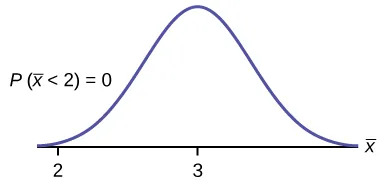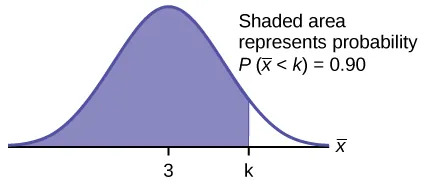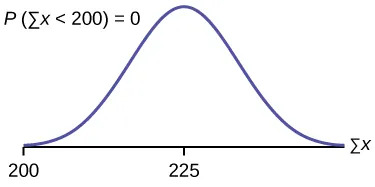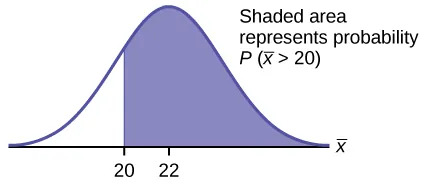The Central Limit Theorem
27 Using the Central Limit Theorem
Before we begin this chapter, it is important for you to understand when to use the central limit theorem (CLT). If you are being asked to find the probability of the mean, use the CLT for the mean. If you are being asked to find the probability of a sum or total, use the CLT for sums. This also applies to percentiles for means and sums.
NOTE
If you are being asked to find the probability of an individual value, do not use the Central Limit Theorem. Use the distribution of its random variable.
Examples of the Central Limit Theorem
Law of Large Numbers
The law of large numbers says that if you take samples of larger and larger size from any population, then the mean $\bar x$ of the sample tends to get closer and closer to μ. From the central limit theorem, we know that as n gets larger and larger, the sample means follow a normal distribution. The larger n gets, the smaller the standard deviation gets. (Remember that the standard deviation for $\bar X$ is $\frac{\sigma}{\sqrt{n}}$. ) This means that the sample mean $\bar x$ must be close to the population mean μ. We can say that μ is the value that the sample means approach as n gets larger. The central limit theorem illustrates the law of large numbers.
Central Limit Theorem for the Mean and Sum Examples
Example 6.8
A study involving stress is conducted among the students on a college campus. The stress scores follow a uniform distribution with the lowest stress score equal to one and the highest equal to five. Using a sample of 75 students, find:
- The probability that the mean stress score for the 75 students is less than two.
- The 90th percentile for the mean stress score for the 75 students.
- The probability that the total of the 75 stress scores is less than 200.
- The 90th percentile for the total stress score for the 75 students.
Let X = one stress score.
Problems a and b ask you to find a probability or a percentile for a mean. Problems c and d ask you to find a probability or a percentile for a total or sum. The sample size, n, is equal to 75.
Since the individual stress scores follow a uniform distribution, X ~ U(1, 5) where a = 1 and b = 5 (In other words, the individual stress scores are uniformly distributed between 1 and 5. See Continuous Random Variables for an explanation on the uniform distribution).
$\mu_x = \frac{a+b}{2}=\frac{1+5}{2}=3$
$\sigma_x = \sqrt{\frac{(b-a)^2}{12}}=\sqrt{\frac{(5-1)^2}{12}}=1.15$
For problems a. and b., let $\bar X =$ the mean stress score for the 75 students. Then,
$\bar X \sim N\left(3, \frac{1.15}{\sqrt{75}} \right)$
Find $P(\bar x <2)$. Draw the graph.
Try It 6.8
Use the information in Example 6.8, but use a sample size of 55 to answer the following questions.
- Find $P(\bar x<7)$.
- Find P(Σx > 170).
- Find the 80th percentile for the mean of 55 scores.
- Find the 85th percentile for the sum of 55 scores.
Example 6.9
Suppose that a market research analyst for a cell phone company conducts a study of their customers who exceed the time allowance included on their basic cell phone contract; the analyst finds that for those people who exceed the time included in their basic contract, the excess time used follows an exponential distribution with a mean of 22 minutes. (Note: you do not need to know anything about the exponential distribution to solve this problem, but if you are curious, you can read about it at Wikipedia).
Consider a random sample of 80 customers who exceed the time allowance included in their basic cell phone contract.
Let X = the excess time used by one INDIVIDUAL cell phone customer who exceeds his contracted time allowance.
$X\sim Exp\left( \frac{1}{22} \right)$. From previous chapters, we know that μ = 22 and σ = 22.
Let $\bar X=$ the mean excess time used by a sample of n = 80 customers who exceed their contracted time allowance.
$\bar X \sim N\left( 22, \frac{22}{\sqrt{80}} \right)$ by the central limit theorem for sample means
- Find the probability that the mean excess time used by the 80 customers in the sample is longer than 20 minutes. This is asking us to find $P(\bar x > 20)$. Draw the graph.
- Suppose that one customer who exceeds the time limit for his cell phone contract is randomly selected. Find the probability that this individual customer’s excess time is longer than 20 minutes. This is asking us to find P(x > 20).
- Explain why the probabilities in parts a and b are different.
Try It 6.9
Use the information in Example 6.9, but change the sample size to 144.
- Find $P(20<\bar x < 30)$.
- Find P(Σx is at least 3,000).
- Find the 75th percentile for the sample mean excess time of 144 customers.
- Find the 85th percentile for the sum of 144 excess times used by customers.
Example 6.10
In the United States, someone is sexually assaulted every two minutes, on average, according to a number of studies. Suppose the standard deviation is 0.5 minutes and the sample size is 100.
- Find the median, the first quartile, and the third quartile for the sample mean time of sexual assaults in the United States.
- Find the median, the first quartile, and the third quartile for the sum of sample times of sexual assaults in the United States.
- Find the probability that a sexual assault occurs on the average between 1.75 and 1.85 minutes.
- Find the value that is two standard deviations above the sample mean.
- Find the IQR for the sum of the sample times.
Try It 6.10
Based on data from the National Health Survey, women between the ages of 18 and 24 have an average systolic blood pressures (in mm Hg) of 114.8 with a standard deviation of 13.1. Systolic blood pressure for women between the ages of 18 to 24 follow a normal distribution.
- If one woman from this population is randomly selected, find the probability that her systolic blood pressure is greater than 120.
- If 40 women from this population are randomly selected, find the probability that their mean systolic blood pressure is greater than 120.
- If the sample were four women between the ages of 18 to 24 and we did not know the original distribution, could the central limit theorem be used?
Example 6.11
A study was done about violence against prostitutes and the symptoms of the posttraumatic stress that they developed. The age range of the prostitutes was 14 to 61. The mean age was 30.9 years with a standard deviation of nine years.
- In a sample of 25 prostitutes, what is the probability that the mean age of the prostitutes is less than 35?
- Is it likely that the mean age of the sample group could be more than 50 years? Interpret the results.
- In a sample of 49 prostitutes, what is the probability that the sum of the ages is no less than 1,600?
- Is it likely that the sum of the ages of the 49 prostitutes is at most 1,595? Interpret the results.
- Find the 95th percentile for the sample mean age of 65 prostitutes. Interpret the results.
- Find the 90th percentile for the sum of the ages of 65 prostitutes. Interpret the results.
Try It 6.11
According to Boeing data, the 757 airliner carries 200 passengers and has doors with a height of 72 inches. Assume for a certain population of men we have a mean height of 69.0 inches and a standard deviation of 2.8 inches.
- What doorway height would allow 95% of men to enter the aircraft without bending?
- Assume that half of the 200 passengers are men. What mean doorway height satisfies the condition that there is a 0.95 probability that this height is greater than the mean height of 100 men?
- For engineers designing the 757, which result is more relevant: the height from part a or part b? Why?
HISTORICAL NOTE
: Normal Approximation to the Binomial
Historically, being able to compute binomial probabilities was one of the most important applications of the central limit theorem. Binomial probabilities with a small value for n(say, 20) were displayed in a table in a book. To calculate the probabilities with large values of n, you had to use the binomial formula, which could be very complicated. Using the normal approximation to the binomial distribution simplified the process. To compute the normal approximation to the binomial distribution, take a simple random sample from a population. You must meet the conditions for a binomial distribution:
- there are a certain number n of independent trials
- the outcomes of any trial are success or failure
- each trial has the same probability of a success p
Recall that if X is the binomial random variable, then X ~ B(n, p). The shape of the binomial distribution needs to be
similar to the shape of the normal distribution. To ensure this, the quantities np
and nq must both be greater than five (np > 5 and nq > 5; the approximation is better if they are both greater than or equal to 10). Then the binomial can be approximated by the normal distribution with mean μ = np and standard deviation $\sigma = \sqrt{npq}$. Remember that q = 1 – p. In order to get the best approximation, add 0.5 to x or subtract 0.5 from x (use x + 0.5 or x – 0.5). The number 0.5 is called the continuity correction factor and is used in the following example.
Example 6.12
Suppose in a local Kindergarten through 12th grade (K – 12) school district, 53 percent of the population favor a charter school for grades K through 5. A simple random sample of 300 is surveyed.
- Find the probability that at least 150 favor a charter school.
- Find the probability that at most 160 favor a charter school.
- Find the probability that more than 155 favor a charter school.
- Find the probability that fewer than 147 favor a charter school.
- Find the probability that exactly 175 favor a charter school.
Let X = the number that favor a charter school for grades K trough 5. X ~ B(n, p) where n = 300 and p = 0.53. Since np > 5 and nq > 5, use the normal approximation to the binomial. The formulas for the mean and standard deviation are μ = np and $\sigma = \sqrt{npq}$. The mean is 159 and the standard deviation is 8.6447. The random variable for the normal distribution is Y. Y ~ N(159, 8.6447).
For part a, you include 150 so P(X ≥ 150) has normal approximation P(Y ≥ 149.5) = 0.8641.
1-NORM.DIST(149.5,159,8.6447,TRUE) = 0.8641.
For part b, you include 160 so P(X ≤ 160) has normal appraximation P(Y ≤ 160.5) = 0.5689.
NORM.DIST(160.5,159,8.6447,TRUE) = 0.5689
For part c, you exclude 155 so P(X > 155) has normal approximation P(y > 155.5) = 0.6572.
1-NORM.DIST(155.5,159,8.6447,TRUE) = 0.6572.
For part d, you exclude 147 so P(X < 147) has normal approximation P(Y < 146.5) = 0.0741.
NORM.DIST(146.5,159,8.6447,TRUE) = 0.0741
For part e,P(X = 175) has normal approximation P(174.5 < Y < 175.5) = 0.0083.
NORM.DISTNORM.DIST
Because of calculators and computer software that let you calculate binomial probabilities for large values of n easily, it is not necessary to use the the normal approximation to the binomial distribution, provided that you have access to these technology tools. In a spreadsheet application (like Google Sheets), you can use the BINOM.DIST() function to calculate binomial distribution probabilities.
For Example 6.10, the probabilities are calculated using the following binomial distribution: (n = 300 and p = 0.53). Compare the binomial and normal distribution answers.
P(X ≥ 150) :1 - BINOM.DIST(149, 300,0.53,TRUE) = 0.8641
P(X ≤ 160) :B INOM.DIST(160,300,0.53,TRUE) = 0.5684
P(X > 155) :1 - BINOM.DIST(155,300,0.53,TRUE) = 0.6576
P(X < 147) : BINOM.DIST(146,300,0.53,TRUE) = 0.0742
P(X = 175) : BINOM.DIST(175,300,0.53,FALSE) = 0.0083 (You use the FALSE argument since we don’t want the cumulative probabilities)





